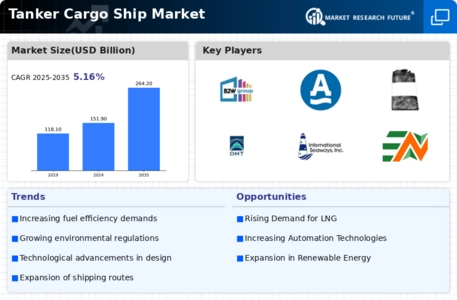Market Trends and Charts
Expansion of Trade Routes
The Global Tanker Cargo Ship Market Industry benefits from the expansion of international trade routes. Strategic initiatives, such as the Belt and Road Initiative, enhance connectivity between regions, facilitating the movement of goods, including oil and gas. This expansion is likely to increase the demand for tanker vessels capable of navigating these routes. As trade volumes rise, the need for efficient transportation solutions becomes paramount. The growth in trade routes not only supports the tanker market but also contributes to the overall economic development of participating countries, indicating a symbiotic relationship between trade and tanker shipping.
Increasing Global Oil Demand
The Global Tanker Cargo Ship Market Industry is experiencing growth driven by the rising global demand for oil. As economies expand, particularly in emerging markets, the need for oil transportation increases. In 2024, the market is valued at approximately 151.9 USD Billion, reflecting the essential role of tanker ships in facilitating this demand. The International Energy Agency projects that global oil consumption will continue to rise, necessitating a robust fleet of tankers to transport crude oil and refined products. This trend suggests that the tanker cargo ship sector will remain a critical component of the global energy supply chain.
Technological Advancements in Shipping
Technological innovations are transforming the Global Tanker Cargo Ship Market Industry. The adoption of advanced navigation systems, fuel-efficient engines, and automation technologies enhances operational efficiency and reduces environmental impact. These advancements are crucial as regulatory frameworks become more stringent regarding emissions and safety standards. For instance, the International Maritime Organization's regulations on sulfur emissions are pushing operators to invest in cleaner technologies. Consequently, the market is likely to see a shift towards modernized fleets that comply with these regulations, potentially increasing the overall market value as companies seek to upgrade their vessels.
Regulatory Compliance and Environmental Standards
The Global Tanker Cargo Ship Market Industry is significantly influenced by regulatory compliance and environmental standards. Governments worldwide are implementing stricter regulations to mitigate the environmental impact of shipping activities. This includes emissions control and ballast water management, which require tanker operators to invest in compliance technologies. As a result, the market may experience a shift towards more environmentally friendly vessels. The financial implications of these regulations could lead to increased operational costs, but they also present opportunities for innovation and differentiation in the market, potentially enhancing the competitive landscape.
Projected Market Growth and Investment Opportunities
The Global Tanker Cargo Ship Market Industry is poised for substantial growth, with projections indicating a market value of 264.2 USD Billion by 2035. This growth is underpinned by a compound annual growth rate of 5.16% from 2025 to 2035. Investors are likely to view this sector as a viable opportunity, given the increasing demand for oil and gas transportation. The anticipated growth may attract new entrants and stimulate investments in fleet expansion and modernization. As the market evolves, stakeholders must remain vigilant to capitalize on emerging trends and shifts in consumer preferences.



















